Jacketed Reactor Temperature Control Thermostat
Contattateci oggi stesso per la soluzione di controllo della temperatura perfetta
In laboratories in the fields of chemistry, biology, medicine and other fields, various chemical reactions and biological experiments are often required. During these experiments, precise temperature control of the reactants is often required to ensure the accuracy and reliability of the experimental results. To meet this need, scientists designed a jacketed reactor temperature control thermostat.
Jacketed reactor temperature control thermostat is a fully automatic control equipment that integrates heating, cooling, temperature control and other functions. It can meet the temperature requirements of different applications and is efficient, stable and convenient. This kind of equipment is mainly used in the pharmaceutical, chemical, and laboratory industries to connect reactors for refrigeration and heating reactions, such as temperature rise and fall, and constant temperature control of glass reactors and metal reactors.
High-precision control of different temperatures is achieved through the technology of combining electric heater heating and compression refrigeration. When the temperature needs to be lowered, the compressor compresses the refrigerant and transfers it to the condenser, where it dissipates heat and converts it into low-temperature gas. The heat-carrying medium is then cooled down through a heat exchanger; when high temperature is required, the system uses electric heating to heat the heat-carrying medium. It is widely used in various fields, such as sample processing and material stability testing in laboratories; heating and cooling of reactors in the chemical industry; component testing and aging experiments in the electronics industry; temperature control of biomedical equipment, etc. Flexibility and reliability make it an indispensable device in many industries.
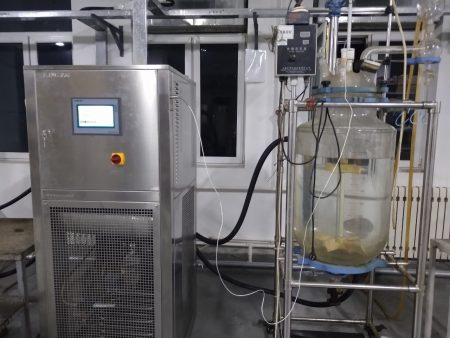
Characteristics of jacketed reactor temperature control thermostat
1. High precision: The use of advanced temperature control system can achieve precise control of the temperature in the reactor and ensure the accuracy of experimental results.
2. High efficiency: Using an efficient heating and cooling system, the set temperature can be reached quickly and the experimental cycle is shortened.
3. Safe and reliable: It has multiple safety protection functions, such as overheating protection, overload protection, etc., to ensure the safety of the experimental process.
4. Easy to operate: The user-friendly operation interface makes the operation simple and convenient, which greatly improves the experimental efficiency.
5. Energy saving and environmental protection: The use of energy-saving heating and cooling technology reduces energy consumption and reduces the impact on the environment.
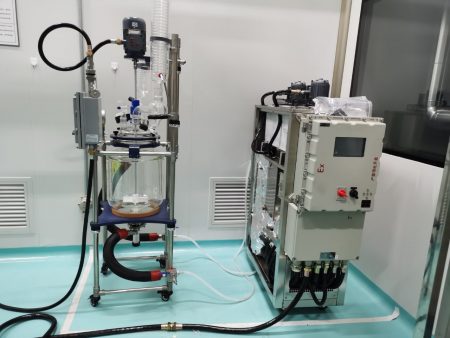
How to use jacketed reactor temperature control thermostat?
1. Place the stainless steel reactor and temperature control thermostat in a dry and ventilated place, and check whether the equipment is damaged or abnormal. Connect the devices according to the interface specifications. Make sure the discharge valve of the stainless steel reactor is closed.
2. Add thermal oil to the temperature control thermostat. Pay attention to the amount of thermal oil added.
3. Open the observation window of the reactor and put in the reaction materials. Make sure not to add more than 80% of capacity and close the lid. Pay attention to ensure that the steps of the PTFE cup and lid are clean, and no foreign matter is allowed.
4. Put the side with the steps downward into the bottom of the kettle body, and put the PTFE cup containing the reaction materials into the kettle body.
5. After screwing the cauldron cover all the way, retreat half a turn. It is strictly prohibited to use a large wrench to tighten. It is necessary to ensure that the power-assist gland returns to its original position.
6. Insert the stainless steel rod into the hole of the booster cover, hold the kettle body with your left hand, and tighten the stainless steel rod clockwise with your right hand. Do not use other power-assisted tools to prevent excessive pressure, otherwise the damage to the PTFE lining will be accelerated and the service life of the lining will be reduced.
7. When placing the reaction kettle inside the oven, there must be enough space inside so that the internal heating cycle can work normally. Close the oven door.
8. Turn on the power switch of the temperature control thermostat and perform heating or cooling operation according to the set temperature.
9. During the reaction process, pay close attention to the temperature changes in the reactor to ensure that the temperature is controlled within the set range.
10. After the reaction is completed, first turn off the power switch of the temperature control thermostat, then wait for the temperature to drop to a safe range before opening the reactor discharge valve and taking out the reaction materials.
Forniamo progettazione e produzione di sistemi di controllo della temperatura completi. Da modelli standard a prodotti completi e personalizzati fino a 900 tonnellate. Siamo specializzati nell'assistenza ai clienti e ci dedichiamo ad aiutare ogni cliente ad avere il sistema di controllo della temperatura ottimale per le sue esigenze specifiche.
Forniamo soluzioni personalizzate non standard. Sono disponibili sia chiller a raffreddamento singolo che unità combinate di raffreddamento e riscaldamento.
E-mail: info@lneya.com ID WeChat: +8615251628237 WhatsApp: +86 17851209193


Sistemi di raffreddamento e riscaldamento (serie SUNDI)
Intervallo di controllo della temperatura: da -120°C a +350°C
termostato di raffreddamento e riscaldamento, ampiamente utilizzato in vari settori industriali.
| Intervallo di temperatura | Serie -10 ~ +150°C | Serie -25 ~ +200°C | Serie -25 ~ +300°C | Serie -45 ~ +250°C | Serie -45 ~ +300°C | Serie -60 ~ +250°C | Serie -60 ~ +300°C | Serie -70 ~ +250°C | Serie -80 ~ +250°C | Serie -90 ~ +250°C | Serie -100 ~ +100°C | ||
| Capacità di raffreddamento | 1,5 ~ 15kW | 1 ~ 200kW | 1 ~ 200kW | 0,45 ~ 200kW | 0,9 ~ 25kW | 0,25 ~ 60kW | 0,75 ~ 25kW | 0,4 ~ 15kW | 0,3 ~ 80kW | 0,2 ~ 80kW | 0,45 ~ 80kW | ||
| Nota: qualsiasi intervallo di temperatura da -150℃ a +350℃ e qualsiasi capacità di raffreddamento possono essere personalizzati. | |||||||||||||
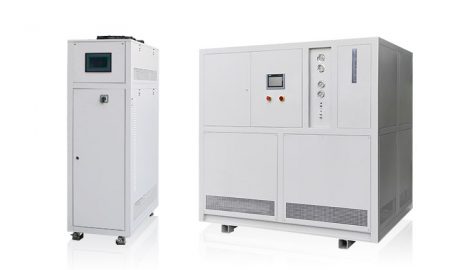
Sistemi di raffreddamento e riscaldamento (serie WTD)
(Micro reattori a canale/tubo specializzati)
Intervallo di controllo della temperatura: da -70°C a +300°C
Design specializzato per il microcanale (piccola capacità di contenimento del liquido, forte capacità di scambio termico, elevata perdita di carico del sistema di circolazione)
| Intervallo di temperatura | -70°C ~ +300°C | -45°C ~ +250°C | -70°C ~ +200°C | ||||||
| Capacità di raffreddamento | 1,1 ~ 7,5kW | 1,5 ~ 5,5kW | 11 ~ 50kW | ||||||
| Nota: qualsiasi intervallo di temperatura da -150℃ a +350℃ e qualsiasi capacità di raffreddamento possono essere personalizzati. | |||||||||

Circolatori di raffreddamento e riscaldamento
Intervallo di controllo della temperatura: da -45°C a +250°C
| Intervallo di temperatura | Serie -25°C ~ +200°C | Serie -45°C ~ +250°C | |||||||
| Capacità di raffreddamento | 1 ~ 15kW | 0,25 ~ 15kW | |||||||
| Nota: qualsiasi intervallo di temperatura da -150℃ a +350℃ e qualsiasi capacità di raffreddamento possono essere personalizzati. | |||||||||
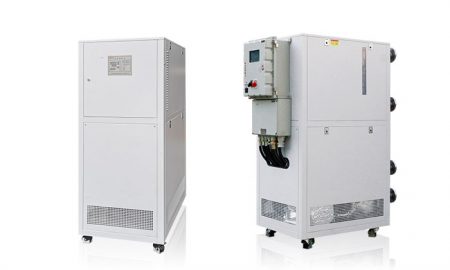
Circolatori di riscaldamento
Intervallo di controllo della temperatura: Da +50°C a +300°C
Nota: la serie UC può controllare la temperatura del mezzo di trasferimento del calore. La serie UST può controllare non solo la temperatura del mezzo di trasferimento del calore, ma anche quella del materiale di reazione.
| Intervallo di temperatura | +50°C ~ +170°C (serie UC) | +50°C ~ +300°C (serie UC) | +50°C ~ +300°C (serie UST) | ||||||
| Capacità di riscaldamento | 5,5 ~ 15kW | 3,5 ~ 130kW | 3,5 ~ 95kW | ||||||
| Nota: qualsiasi intervallo di temperatura da -150℃ a +350℃ e qualsiasi capacità di raffreddamento possono essere personalizzati. | |||||||||
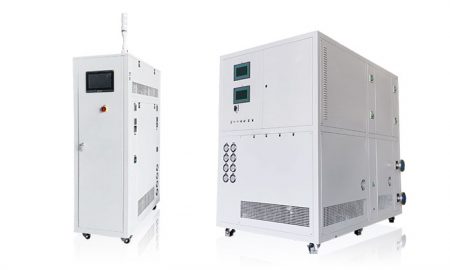
Serie TES
Intervallo di controllo della temperatura: da -85°C a +250°C
| Intervallo di temperatura | Serie -45°C ~ +250°C | Serie -85°C ~ +200°C | Serie -60°C ~ +200°C | ||||||
| Capacità di raffreddamento | 0,3 ~ 25kW | 0,25 ~ 25kW | 3 ~ 60kW | ||||||
| Nota: qualsiasi intervallo di temperatura da -150℃ a +350℃ e qualsiasi capacità di raffreddamento possono essere personalizzati. | |||||||||

Serie LTS (liquido fluorurato)
Intervallo di controllo della temperatura: da -80°C a +80°C
| Intervallo di temperatura | Serie -20°C ~ +80°C | Serie -45°C ~ +80°C | Serie -60°C ~ +80°C | Serie -80°C ~ +80°C | |||||
| Controllo del flusso | 7 ~ 45 L/min | 7 ~ 45 L/min | 7 ~ 45 L/min | 7 ~ 45 L/min | |||||
| Nota: qualsiasi intervallo di temperatura da -150℃ a +350℃ e qualsiasi capacità di raffreddamento possono essere personalizzati. | |||||||||
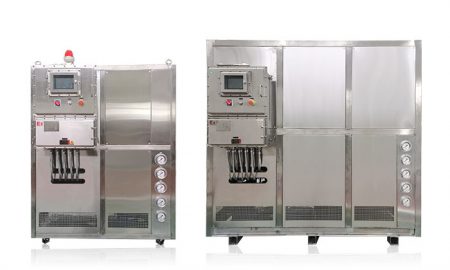
TCU Sistema di controllo della temperatura dei multireattori
Intervallo di controllo della temperatura: da -120°C a +250°C
| Intervallo di temperatura | Serie -45°C ~ +250°C | Serie -120°C ~ +250°C | Sistema di controllo della temperatura personalizzato | RT+10°C ~ +135°C | |||||
| Capacità di riscaldamento | 25 ~ 80kW | 25 ~ 80kW | Personalizzato | 25 ~ 300kW | |||||
| Nota: qualsiasi intervallo di temperatura da -150℃ a +350℃ e qualsiasi capacità di raffreddamento possono essere personalizzati. | |||||||||
Refrigeratori di raffreddamento

Refrigeratori a ricircolo / Circolatore refrigerato
Il refrigeratore può essere ampiamente utilizzato in vari settori industriali e laboratori e supporta la progettazione personalizzata.
| Intervallo di temperatura | Serie -25°C ~ +30°C | Serie -45°C ~ +30°C | Serie -60°C ~ -20°C | Serie -80°C ~ -20°C | Serie -120°C ~ -70°C | ||||
| Capacità di raffreddamento | 0,8 ~ 30kW | 0,75 ~ 12kW | 0,4 ~ 6kW | 0,2 ~ 6kW | 0,3 ~ 5kW | ||||
| Nota: qualsiasi intervallo di temperatura da -150℃ a +350℃ e qualsiasi capacità di raffreddamento possono essere personalizzati. | |||||||||
 Refrigeratori d'acqua / Piccoli refrigeratori
Refrigeratori d'acqua / Piccoli refrigeratori
Il refrigeratore può essere ampiamente utilizzato in vari settori industriali e laboratori e supporta la progettazione personalizzata.
| Intervallo di temperatura | -18°C ~ +30°C | Serie +5°C ~ +35°C | |||||||
| Capacità di raffreddamento | 0,35 ~ 0,9 kW | 1,8 ~ 50kW | |||||||
| Nota: qualsiasi intervallo di temperatura da -150℃ a +350℃ e qualsiasi capacità di raffreddamento possono essere personalizzati. | |||||||||

Refrigeratori a bassa temperatura
Siamo specializzati nella produzione di refrigeratori a bassa temperatura con un range di controllo della temperatura fino a -150°C, in grado di soddisfare le esigenze di refrigerazione di diversi settori industriali.
| Intervallo di temperatura | Serie -25°C ~ -5°C | Serie -45°C ~ -10°C | Serie -60°C ~ -10°C | Serie -80°C ~ -30°C | Serie -110°C ~ -50°C | Serie -150°C ~ -110°C | |||
| Capacità di raffreddamento | 12 ~ 360kW | 6 ~ 180kW | 6 ~ 180kW | 4 ~ 180kW | 2 ~ 120kW | 2,5 ~ 11kW | |||
| Nota: qualsiasi intervallo di temperatura da -150℃ a +350℃ e qualsiasi capacità di raffreddamento possono essere personalizzati. | |||||||||
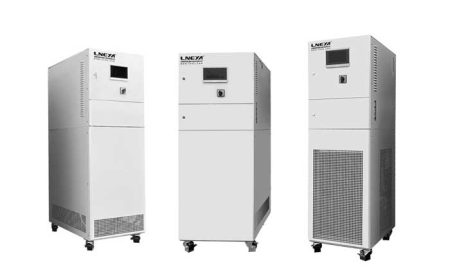
Refrigeratori ad alta temperatura
Il refrigeratore può essere ampiamente utilizzato in vari settori industriali e laboratori e supporta la progettazione personalizzata.
| Intervallo di temperatura | +5°C ~ +40°C | -25°C ~ +40°C | -45°C ~ +40°C | -80°C ~ +80°C | -100°C ~ +80°C | ||||
| Capacità di raffreddamento | 6 ~ 40kW | 2 ~ 15kW | 1 ~ 8kW | 0,6 ~ 3kW | 1,5 ~ 3kW | ||||
| Nota: qualsiasi intervallo di temperatura da -150℃ a +350℃ e qualsiasi capacità di raffreddamento possono essere personalizzati. | |||||||||
 LNEYA
LNEYA
 简体中文
简体中文


















































































